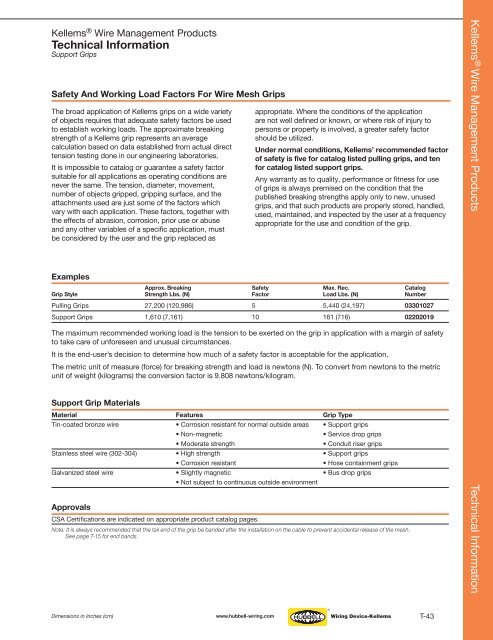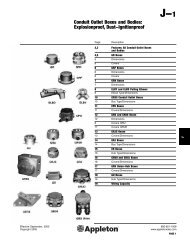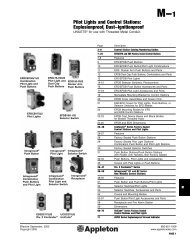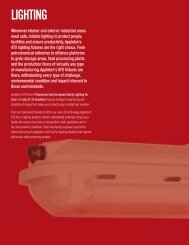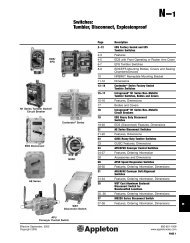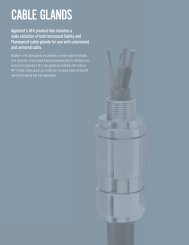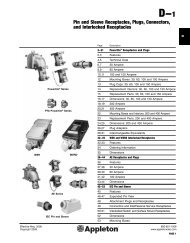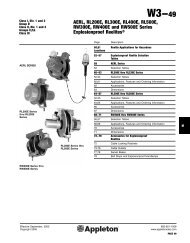Kellems® Wire Management Products
Kellems® Wire Management Products
Kellems® Wire Management Products
You also want an ePaper? Increase the reach of your titles
YUMPU automatically turns print PDFs into web optimized ePapers that Google loves.
Kellems ® <strong>Wire</strong> <strong>Management</strong> <strong>Products</strong><br />
Technical Information<br />
Support Grips<br />
Safety And Working Load Factors For <strong>Wire</strong> Mesh Grips<br />
The broad application of Kellems grips on a wide variety<br />
of objects requires that adequate safety factors be used<br />
to establish working loads . The approximate breaking<br />
strength of a Kellems grip represents an average<br />
calculation based on data established from actual direct<br />
tension testing done in our engineering laboratories .<br />
It is impossible to catalog or guarantee a safety factor<br />
suitable for all applications as operating conditions are<br />
never the same . The tension, diameter, movement,<br />
number of objects gripped, gripping surface, and the<br />
attachments used are just some of the factors which<br />
vary with each application . These factors, together with<br />
the effects of abrasion, corrosion, prior use or abuse<br />
and any other variables of a specific application, must<br />
be considered by the user and the grip replaced as<br />
Examples<br />
Approx. Breaking Safety Max. Rec. Catalog<br />
Grip Style Strength Lbs. (N) Factor Load Lbs. (N) Number<br />
Pulling Grips 27,200 (120,986) 5 5,440 (24,197) 03301027<br />
Support Grips 1,610 (7,161) 10 161 (716) 02202019<br />
The maximum recommended working load is the tension to be exerted on the grip in application with a margin of safety<br />
to take care of unforeseen and unusual circumstances .<br />
It is the end-user’s decision to determine how much of a safety factor is acceptable for the application .<br />
The metric unit of measure (force) for breaking strength and load is newtons (N) . To convert from newtons to the metric<br />
unit of weight (kilograms) the conversion factor is 9 .808 newtons/kilogram .<br />
Support Grip Materials<br />
Material Features Grip Type<br />
Tin-coated bronze wire • Corrosion resistant for normal outside areas • Support grips<br />
• Non-magnetic • Service drop grips<br />
• Moderate strength • Conduit riser grips<br />
Stainless steel wire (302-304) • High strength • Support grips<br />
• Corrosion resistant • Hose containment grips<br />
Galvanized steel wire • Slightly magnetic • Bus drop grips<br />
• Not subject to continuous outside environment<br />
Approvals<br />
CSA Certifications are indicated on appropriate product catalog pages .<br />
Note: It is always recommended that the tail end of the grip be banded after the installation on the cable to prevent accidental release of the mesh.<br />
See page T-15 for end bands.<br />
Dimensions in Inches (cm) www.hubbell-wiring.com<br />
appropriate . Where the conditions of the application<br />
are not well defined or known, or where risk of injury to<br />
persons or property is involved, a greater safety factor<br />
should be utilized .<br />
Under normal conditions, Kellems’ recommended factor<br />
of safety is five for catalog listed pulling grips, and ten<br />
for catalog listed support grips.<br />
Any warranty as to quality, performance or fitness for use<br />
of grips is always premised on the condition that the<br />
published breaking strengths apply only to new, unused<br />
grips, and that such products are properly stored, handled,<br />
used, maintained, and inspected by the user at a frequency<br />
appropriate for the use and condition of the grip .<br />
T-43<br />
Kellems ® <strong>Wire</strong> <strong>Management</strong> <strong>Products</strong> Technical Information


